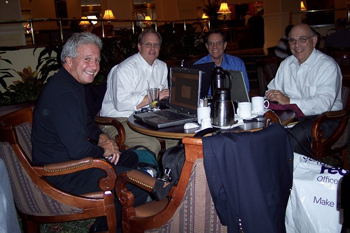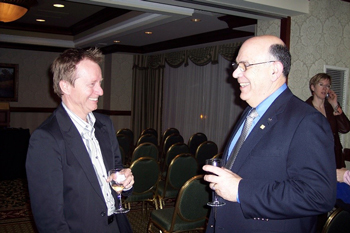Raymond Peter Zambuto has been inducted into the Clinical Engineering Hall of Fame in recognition of his significant contributions to the advancement of the profession in three key areas: Ray co-founded one of the nation’s first shared clinical engineering services which helped to grow and expand the field of clinical engineering. He was also a prime driver of many of the clinical engineering initiatives in clinical systems engineering and the integration of medical and information systems, directly influencing the careers of many. Finally, Ray foresaw the vital importance of establishing strong relationships between CE and IT leaders in their respective professional organizations and became the driving force behind ACCE becoming a co-sponsor of and a key player in IHE's Patient Care Device Domain (PCD).
Education:
- B.S. (E.E.) Polytechnic Institute of Brooklyn, New York
- M.S. (Bio-Engineering) Polytechnic Institute of Brooklyn, New York, Thesis: "Modeling Mechanical Factors of Respiration"
Certification, Registration and Peer Recognition:
- Certified Clinical Engineer (AAMI)
- Certified in Clinical Engineering (HTCC)
- Institute of Electrical & Electronic Engineers Student Paper Contest New, York City Regional Finalist
- National Institutes of Health Trainee
- National Institutes of Health Special Fellow
- Fellow, American Society for Healthcare Engineering
- Thomas O’Dea Advocacy Award - ACCE
- Excellence in Clinical Engineering Information Technology Synergies Award, jointly presented by HIMSS and ACCE
- Fellow, Healthcare Information Management & Systems Society
- Fellow, American College of Clinical Engineering
- ACCE Lifetime Achievement Award, American College of Clinical Engineering
Summary of Career:
Ray entered the clinical engineering profession in 1968 and worked with some very prestigious engineers and physicians at some very significant hospitals and organizations. Early in his career he was drawn to cardiology and the technology that supported the science. Like many clinical engineers, Ray had the opportunity to be involved in the development of new technologies, such as the Counter Pulsation Balloon Pump, Thermodilution Cardiac Output, and Holter Monitoring. Intrigued with the field of computing, Ray interfaced new technologies with computers as medical engineering liaison to the Harvard Computing Group at Massachusetts General Hospital in Boston. He developed interfaces to allow real-time analysis of cardiac arrhythmias.
In 1973, Ray was named assistant director of the Medical Equipment Program for the Massachusetts Hospital Association. This shared service was one of the building blocks for what would become Technology in Medicine (TiM). Ray was the president and one of the founders of TiM. Over the next forty years, TiM grew from a provider of preventive maintenance to medical equipment to a full service clinical engineering firm. In the late 70s, Ray's responsibilities at TiM changed from providing clinical engineering services to chief executive of the growing company. Ray remained at the helm through two acquisitions. When he retired in 2014, TiM's successor, ABM Health, would employ over 500 individuals and offer a full complement of clinical and healthcare facility engineering, and other related services to healthcare. These services benefited hundreds of healthcare providers nationwide by reducing the costs associated with the technology and improving patient safety.
With all the challenges in healthcare, Ray remained true to his roots and became more active in professional societies and committees. He served as chairman of several committees for AAMI, ASHE, ACCE, HIMMS, IEEE, and SIA. He organized local and national forums where clinical engineers could exchange ideas and best practices. He was a member of the United States Board of Examiners in Clinical Engineering of the ICC and a member of the editorial advisory board for 24x7 magazine.
As an industry expert, Ray has presented papers to numerous national and international audiences. His reach extended beyond clinical engineers to hospital executives, business leaders, and the faculty of various educational institutions. Ray has always been willing to promote the value of clinical engineering. At the same time, Ray continued to develop products and strategies to support the field of clinical engineering. In 1983, Ray worked with Malcolm Ridgway and others to design an insurance approach that reduced equipment maintenance costs for hospitals by employing sound clinical engineering principles. The "product" became an important part of the portfolio offered by MasterPlan, an independent service company that started out as a subsidiary of the Hospital Council of Southern California.
Ray developed computerized maintenance management system (CMMS) applications to drive standardization and service quality at TiM which was one of the first independent service organizations to offer computerized documentation and remote access to medical equipment records.
Ray continued to explore the synergies of medical equipment and IT systems. He published several papers on the topic well before it was more widely accepted within the profession. Working within HIMSS, he helped create paths for clinical engineers and healthcare IT professions to interface and collaborate on healthcare issues.
Below are some extracts from the material provided for his nomination:
"Today many of Ray's pioneering insights are shared by the entire clinical engineering community. Ray was never one to seek the spotlight but was always pleased to see one of his peers get the recognition they deserved. He created the opportunity for hundreds of individuals to succeed in the profession. Ray's company, TiM was an organization that valued new ideas and doing the "right thing the first time"."
"Ray's leadership is marked by participation and commitment, not only by the identification of solutions to unmet needs. A glance at his CV shows leadership of and commitment to the success of Technology in Medicine, of ABM, of the IHE PCD, and of ACCE."
"Ray isn't content to just sit on a committee. He contributes time, effort, creativity, and leadership by taking on a serious role."
"Ray understood like no other that CEs cannot rest on past accomplishments, nor can CE allow itself to be defined only by medical devices or equipment repair. Ray understood – and actively supported – the expansion of the CE profession into laboratory, radiology, information technology, cybersecurity, health policy, and related fields. He also understood the need to mentor a community of younger, diverse CEs so they could become the future leaders, and gave his time selflessly to that cause."
"No other CE in the US has had as broad, constructive, and thoroughly positive impact on our profession than Ray Zambuto. An unappreciated contribution of Ray's is his extremely capable support, stewardship, and mentorship of many younger female CEs who, frankly, did not have much prior opportunity for leadership and advancement. Ray ensured that several very capable young women in our field successfully advanced from VP to President roles in ACCE. His honorable and very professional contribution to this aspect of CE and ACCE success should never be overlooked."
"NOBODY, and I mean nobody at all, compares with Rays inimitable professional style and demeanor. He has represented CE and ACCE with such panache that it may be a long time before we see a comparable leader. He has been a superb and dedicated clinical engineer, and a true ACCE leader hero."
"During Ray's tenure in ACCE leadership (including two years as president), he recognized the growing importance of medical and information technology convergence and worked to establish strong relationships between CE and IT leaders in their respective professional organizations. Working with HIMSS on behalf of ACCE, Ray ensured that ACCE, clinical engineering professionals and medical device technology would play a significant role in the Integrating the Healthcare Enterprise (IHE) initiative … an initiative that was originally founded by HIMSS and RSNA to ensure effective integration of IT and imaging processes. As a result of that work ACCE became the co-sponsor for IHE's Patient Care Device Domain (PCD)."
"While not always the most noticeable, Ray was there, quietly shaping this profession, from designing advances in patient care, through managing programs, to creating shared service business models and bringing healthcare professionals together."
"Ray strives for excellence in all that he does. He is a strong industry leader, influencer and advocate for ACCE's mission. He recognizes the importance of standards-based interoperable devices and health IT systems to achieve accurate, seamless, effective and secure health information exchange practices worldwide, and willingly shares his expertise with the profession to advance that cause."

Laying the groundwork for IHE-PCD with Jack Harrington, Todd Cooper, Manny Furst, Elliot Sloane (behind the camera) and a lot of coffee, Sept 2005 in Washington D.C. |

Ray shared a lighter moment after a successful IHE-PCD launch with HIMSS President, Steve Lieber. |